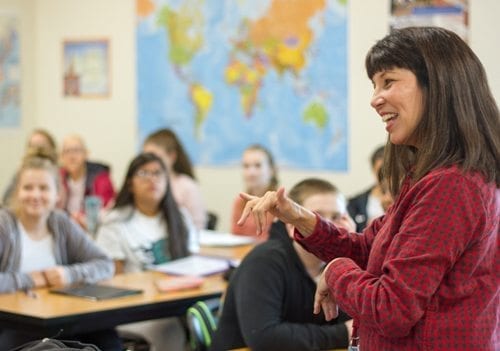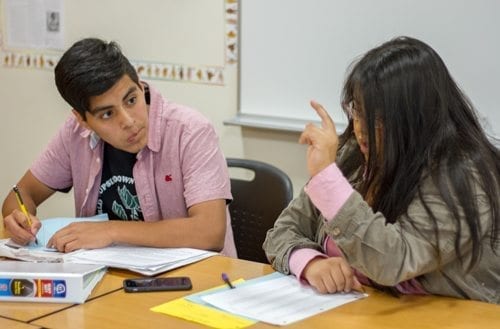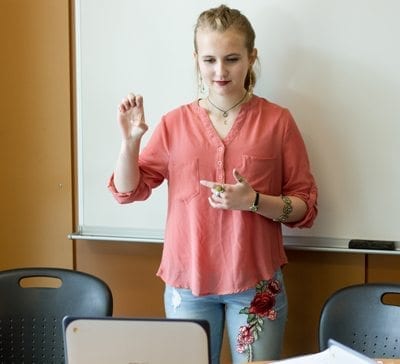WOODLAND — Beginning with the 2017-18 school year, Woodland High School started offering students American Sign Language (ASL) to fulfill foreign language requirements thanks to the hiring of Kim Novak, an experienced teacher from Arizona who developed a three-year program to teach ASL at the high school level.
As more and more cultures adopt English as their primary or secondary language, many foreign languages have seen a drop in use over recent years. However, ASL continues to grow in use and is ranked as the fourth most commonly used language in the United States with between 500,000 to 2 million people using ASL on a daily basis.
Noticing a decline in students enrolling in French classes for their foreign language requirement, Woodland High School Principal John Shoup wanted to broaden the school’s foreign language offerings by adding ASL to the curriculum. Like any language, ASL maintains its own syntax and grammatical structure, and classes in ASL are now widely offered at college to fulfill students’ foreign language requirement in university.

When Shoup reached out to her, Kim Novak was teaching ASL at a high school in Chandler, AZ using a three-year program she developed.
“I had found Kim’s resume and kept it on file for nearly two years because of her background both in foreign language teacher and as a history teacher which makes her a perfect fit for our school,” explained Shoup. “When the opportunity to hire her developed early this year, I knew I needed to see if she was still interested in teaching in the Pacific Northwest.”
Novak wanted to move to the Pacific Northwest for years, so, after waiting patiently for years, Woodland High School was the perfect opportunity.
“More than two years ago, I put ASL on my resume and applications in job search engines online, but I never heard any interest from schools in the Pacific Northwest which is where I really wanted to move,” said Novak. “So, I continued to wait when, last May, John Shoup emailed me asking if I wanted to help start an ASL program at Woodland High School; and, now, here I am!”
For her first year, Novak teaches a combination of courses in the first level of ASL along with a few history courses. Shoup and Novak worked together to schedule her course load to leave room in her schedule to add the second level of ASL for students who progress next year.
“Currently, we’re offering three sections of ASL 1 with 30 students in each section,” Novak explained. “Next year, we’ll continue offering sections of ASL 1 but also add sections of ASL 2 for students who want to continue developing their language skills.”

Thanks to advancements in technology and the power of cloud computing, Novak’s ASL classes are more effective and efficient than ever. Students use the webcams in Chromebook computers and a program called FlipGrid to film themselves “speaking” sign language. The students’ videos are automatically uploaded to Novak’s teacher account where she can review their progress, grade assignments, and provide feedback.
“Since ASL is a visual language with no written component other than English and I can’t watch each student all the time, I’ve always needed students to film themselves so I can monitor their progress and offer instruction,” explained Novak. “In the past, I had to set up a tripod with a camera in class, but students could only film themselves one at a time; now each student can use their own Chromebook – it’s fantastic!”
Students quickly filled the available sections of ASL, enthusiastically enrolling in the new course.
“I already speak Spanish, I didn’t want to take French, and I saw a television show featuring sign language when I was young which made me always want to learn sign language,” explained Belen Toledo, a sophomore. “ASL is so grammatically different than English or Spanish with its own completely unique sentence structure – it’s fascinating.”
Victor Villa, a sophomore classmate, shared a lot of Toledo’s sentiments.
“I was intrigued with how deaf people communicate, and although I was interested in French, I decided to take ASL instead,” he said. “It’s harder to learn ASL than other foreign languages because there’s no writing – you have to memorize a visual language – however, it’s easy to pick up, you just need to put in the effort to memorize the motions.”
Both students raved about Novak’s teaching style.
“Mrs. Novak is a really good teacher offering help for students both before and after school,” said Toledo. “She’s one of my favorites, already!” Villa agreed, “Mrs. Novak also slows down in class whenever students need her to and patiently works with those who need extra guidance.”

Novak holds a Bachelor’s degree in Deaf Studies from California State University in Northridge where she learned American Sign Language from instructors who were completely deaf.
“Participating directly in deaf culture inspired me, and I worked at the National Center on Deafness located on campus at my university,” said Novak. “I have always incorporated some elements of ASL into my classes, however I’m incredibly excited to teach the language and culture directly to students in this program.’
Novak has taught school for 19 years, beginning with fourth grade, followed by middle school Social Studies, and then high school geography, social studies, history and American Sign Language for the past eight years.
“I entered teaching after working in the business world serving the deaf and disabled communities,” explained Novak. “For me, teaching really does offer the chance for me to make a difference in kids’ lives by teaching young people learn the language to communicate with those who are deaf.”
Novak enjoys working with students and watching their progress over time.
“Seeing their growth as a student and as a person makes all the hard work worthwhile,” she said. “I strongly believe that all students can learn; I just need to find the connection and motivation to give them the confidence to pursue their goals and dreams.”
Information provided by Woodland Public Schools.




